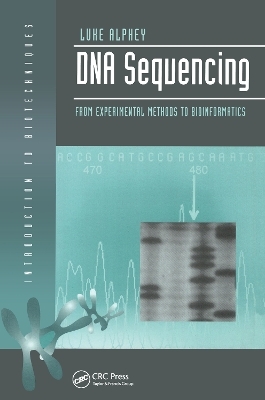
DNA Sequencing
Seiten
1997
Bios Scientific Publishers Ltd (Verlag)
978-1-85996-061-5 (ISBN)
Bios Scientific Publishers Ltd (Verlag)
978-1-85996-061-5 (ISBN)
- Titel z.Zt. nicht lieferbar
- Versandkostenfrei innerhalb Deutschlands
- Auch auf Rechnung
- Verfügbarkeit in der Filiale vor Ort prüfen
- Artikel merken
The technique of DNA Sequencing lies at the heart of modern molecular biology. Since current methods were first introduced, sequence databases have grown exponentially, and are now an indispensable research tool. This up-to-date, practical guide
The technique of DNA Sequencing lies at the heart of modern molecular biology. Since current methods were first introduced, sequence databases have grown exponentially, and are now an indispensable research tool. This up-to-date, practical guide is unique in covering all aspects of the methodology of DNA sequencing, as well as sequence analysis. It describes the basic methods (both manual and automated) and the more advanced techniques (for example, those based on PCR) before moving on to key applications. The final section focuses on the analysis of sequence data; it details the software available, and explains how the Internet can be used for accessing software and major databases.
By explaining the options available and their merits, DNA Sequencing allows newcomers to the field to decide which method is the most suitable for their application. For experienced sequencers the book is a useful reference source for details of the less common techniques and as a means of updating knowledge.
The technique of DNA Sequencing lies at the heart of modern molecular biology. Since current methods were first introduced, sequence databases have grown exponentially, and are now an indispensable research tool. This up-to-date, practical guide is unique in covering all aspects of the methodology of DNA sequencing, as well as sequence analysis. It describes the basic methods (both manual and automated) and the more advanced techniques (for example, those based on PCR) before moving on to key applications. The final section focuses on the analysis of sequence data; it details the software available, and explains how the Internet can be used for accessing software and major databases.
By explaining the options available and their merits, DNA Sequencing allows newcomers to the field to decide which method is the most suitable for their application. For experienced sequencers the book is a useful reference source for details of the less common techniques and as a means of updating knowledge.
Dr Luke Alphey
What is DNA Sequencing? Chemical degradation (Maxam and Gilbert) method. Chain termination (Sanger dideoxy) method. Instrumentation and reagents. Template preparation. Gel electrophoresis. Non-radioactive methods. Troubleshooting. Confirmatory sequencing. Sequencing PCR products. Strategies for new sequence determination. Introduction to Bioinformatics and the Internet. Sequence databases. Sequence alignment and database searches. Sequencing projects and Contig analysis. Protein function prediction. Protein structure prediction. Appendices.
| Erscheint lt. Verlag | 15.6.1997 |
|---|---|
| Verlagsort | London |
| Sprache | englisch |
| Maße | 156 x 234 mm |
| Gewicht | 428 g |
| Themenwelt | Mathematik / Informatik ► Informatik ► Datenbanken |
| Informatik ► Weitere Themen ► Bioinformatik | |
| Studium ► 2. Studienabschnitt (Klinik) ► Humangenetik | |
| Naturwissenschaften ► Biologie ► Genetik / Molekularbiologie | |
| ISBN-10 | 1-85996-061-8 / 1859960618 |
| ISBN-13 | 978-1-85996-061-5 / 9781859960615 |
| Zustand | Neuware |
| Haben Sie eine Frage zum Produkt? |
Mehr entdecken
aus dem Bereich
aus dem Bereich
Buch | Softcover (2021)
Springer Spektrum (Verlag)
49,99 €
Grundlagen, Algorithmen, Anwendungen
Buch | Hardcover (2022)
Wiley-VCH (Verlag)
79,90 €


